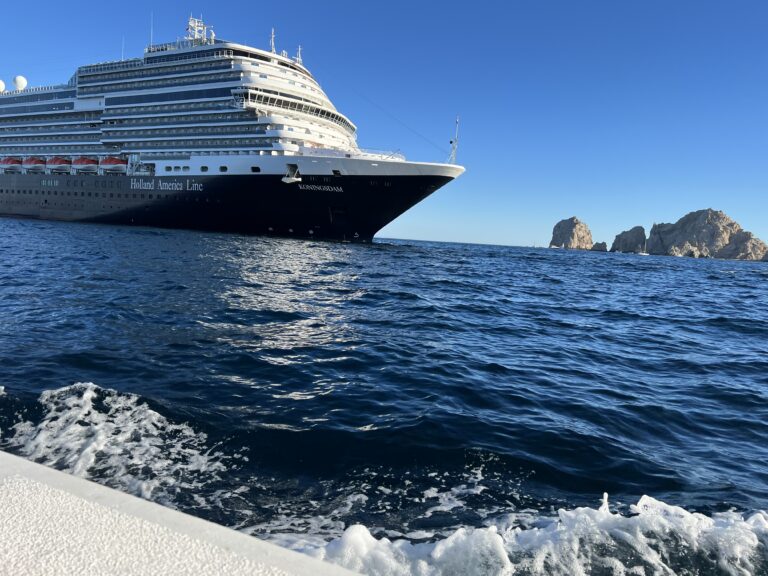Baja California Sur, Mexico — Chabad has established vibrant and growing Jewish communities on either side of the southern tip of the Baja California Sur peninsula. The larger one, on the Pacific Ocean side in Cabo San Lucas, has strong connections to San Diego County. The other in La Paz, along the Sea of Cortez, is smaller yet also quite active.
In Cabo, the Jewish center including the Eliyahu Hanavi Synagogue, a mikvah, two kosher restaurants, rabbi’s residence, meeting facilities and four rooms for guest lodging, was financed by a $12 million contribution from virologist/ pharmacologist Dr. Raymond Schinazi, who developed drugs to combat HIV, and Hepatitis B and C. The center was dedicated during Chanukah of 2021.
In La Paz, the center, also built around a courtyard, was financed in 2013 with contributions from local merchants, including one man, for whose late brother, Yona, the synagogue was named as Beit Yona.
With the distance between the two shuls about 100 miles, Rabbi Benny Hershcovich in Cabo and Rabbi Yosef Gutierrez in La Paz share outreach to Jews in other, more isolated, communities in Baja California Sur.
Tijuana businessman Jose Galicot, a leader of Mexican Jews on both sides of the border, has a vacation home in Cabo San Lucas. He told me that he was moved by an exhibit at the Museum of the Diaspora in Israel that featured a time map of Jewish communities around the world. It showed the European continent brightly illuminated by lights representing numerous cities, towns and villages before the Holocaust. As the timeline moved into the 1930s and 1940s, light after light was extinguished. “I want to be responsible for turning lights on,” Galicot said. So, he arranged for Rabbi Mendel Polichenco, then of Chabad of Tijuana and today at Chabad of Carmel Valley, to join him in Cabo for a meeting at which were pulled together about 30 Jews reflecting the community makeup – 10 each from Israel, Mexico and the United States.
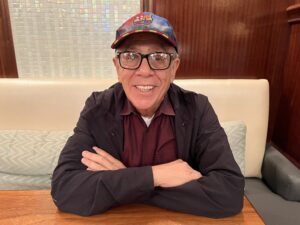
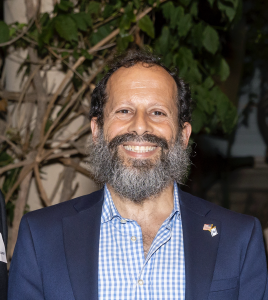
Galicot persuaded most of them to serve on a temporary board for the new Jewish community, which Rabbi Polichenco visited once a month for two years, bringing kosher foods for Shabbat and Pesach in addition to leading services. Eventually, the community persuaded Orthodox Rabbi Sholly Silver from England to serve for about a year. After Silver’s tenure ended, Rabbi Polichenco recruited Rabbi Hershcovich, whose wife Sonia is the sister of Rabbi Polichenco’s wife, Dini. It was a good fit for the informal beachside community. “Rabbi Benny,” as he is called, has a knack for making Jewish learning fun, as readily can be seen by his rabbibenny.com videos about Torah portions and holidays. Another of his wife’s siblings is Rabbi Yosef Rodal, who heads the Carlsbad-based Friendship Circle, an outreach group for Jews with disabilities. Rodal’s wife, Muka, is the daughter of Rabbi Yeruchem Eilfort of Chabad of La Costa. Sonia, Dini, and Yosef were among 17 children of the late Rabbi Shlomo Rodal of Milan, Italy.
Jonathan Pikoff, a real estate attorney, met Dr. Schinazi at the club at the high-end El Dorado development where they both have vacation homes, and told him about the small Jewish congregation. That was prior to Rabbi Benny’s arrival in 2009. Once the rabbi came on scene, Schinazi said he was very impressed by his and Sonia’s dedication. “He lived in a small house. He used one room for his family, and the dining room as a kitchen for the whole community. Some nights he had three or four people, some nights 10, and some nights as many as 30 people in that small place. What I loved about him was his strong faith, passion, and, you know, Sonia cooked meals for us. It didn’t matter how many people there were, you just showed up, and you were welcome. She somehow made it happen with lots of salad, lots of rice, but also a piece of meat or a piece of chicken, so it worked. People enjoyed the camaraderie. It was really like a bunch of pioneers in Baja California making all these prayers and singing!”
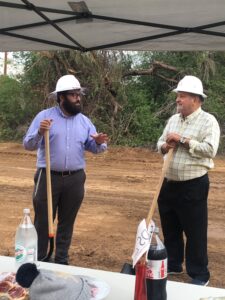
Schinazi described Cabo San Lucas as “a paradise, but paradise without a synagogue is not paradise. I needed the spirituality; I needed a place to worship. I also wanted to provide Rabbi Benny some stability and also to have a home within the center which would be a great improvement on his lifestyle so that he can focus on giving classes, davening, and doing the things he does well. So, he now has a gorgeous place to live in compared to the little apartment. He has six kids, and the apartment is big enough, and the center has four guest rooms, so they have space when family comes to visit him.”
Perhaps the crowded living conditions the Hershcovich family had endured reminded Schinazi of his own youth after his parents’ home and businesses in Alexandria were seized on the orders of the Eygptian dictator Gamel Abdel Nasser. He was 13 when his family fled as impoverished refugees to Naples, Italy. Schinazi said that he was able to attend a Jewish day school on scholarship in England, leading eventually to a bachelor’s degree and a PhD in chemistry at the University of Bath. From there he went on to post-doctorate work at Yale University and eventually joined the Emory University faculty where he developed protocols for handling dangerous viruses in laboratories, and led in the discovery of the drugs known as FTC (emtricitabine) and 3TC (lamivudine) which are widely used in anti-HIV combinations, and sofosbuvir (Sovaldi) for the treatment of Hepatitis-C. France awarded him its Chevalier de la Legion d’Honneur for his discoveries, just one of many honors he has received.
Rabbi Hershcovich said when he heard what Dr. Schinazi wanted to do for Cabo’s Jewish community, “it was beyond our wildest imagination; it was like winning the lottery. He sent a significant donation that day to show that he was serious and he has been the angel ever since.” It took several years before a property could be found that was close enough to attract tourists as well as residents. The architectural planning and construction took a few more years. “We struggle to get a minyan, but we have seating for 90, and we are so optimistic that we have an extension that could bring it to 140,” Rabbi Hershcovich said. “It is a testament to our optimism about the future and our belief that the city will grow and that many opportunities will come up.”
On the Shabbat that my wife Nancy and I visited, there were approximately 20 men and 10 women in attendance at the service, and about 10 more who were treated to a kiddush luncheon with cholent, home-baked challah, and a variety of salads.
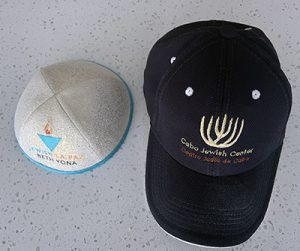

Traveling aboard the Holland-America ship MS Koningsdam, we arrived in La Paz the next day, a Sunday, and met Rabbi Yosef Gutierrez who grew up in a secular family in Guadalajara and Los Angeles, deciding as a teenager to become ba’al teshuva. After receiving smicha in 2015, he took a job as an administrator and teacher of a 20-student yeshiva that temporarily made its headquarters in the Baja California Sur capital city. Because the yeshiva taught mostly in English, it didn’t catch on with the local Spanish-speaking Jews and eventually it moved to New York.
Rabbi Yosef took a vacation in New York, where a matchmaker introduced him to his future wife, Rochel, daughter of two Chicago lawyers. After their marriage, they moved to California, from which he was recruited by the La Paz Jewish community lay leadership to return and to serve as their rabbi.
“Since then our attendance has been growing,” Gutierrez told me. “We have 120 Jewish families in the area” of which 30 people are regular attendees, 50 to 60 participate in High Holy Day activities, and the congregation’s Passover seders have drawn as many as 90 people.
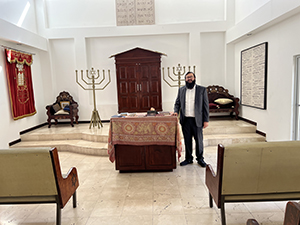
He defined for himself various objectives: First, demonstrating local Jewish families that they could lead full Jewish lives without having to be Talmudic scholars. Second, holding open forums to answer any questions or misapprehensions that non-Jewish citizens of La Paz might have about Judaism. Third, contributing to the welfare of La Paz by supporting local orphanages and providing gifts during the holiday season to people who are down on their luck.
At Shabbat kiddushes, he said, they sometimes serve Ashkenazi food, sometimes Sephardic food, and sometimes Mexican food. Kosher food is imported from Mexico City. “There are never less than 300 pounds of kosher meat at the synagogue, which is available for purchase by our local community members,” the rabbi noted.
The La Paz Jewish Center offers classes for children and maintains a small shop selling items of Judaica.
Guiterrez described Rabbi Benny Hershcovich, with whom he trades visits, as “not only a colleague, but the closest to being family that you can get.”
This story is republished from the March issue of L’Chaim San Diego Magazine. Donald H. Harrison is editor emeritus of San Diego Jewish World.


























